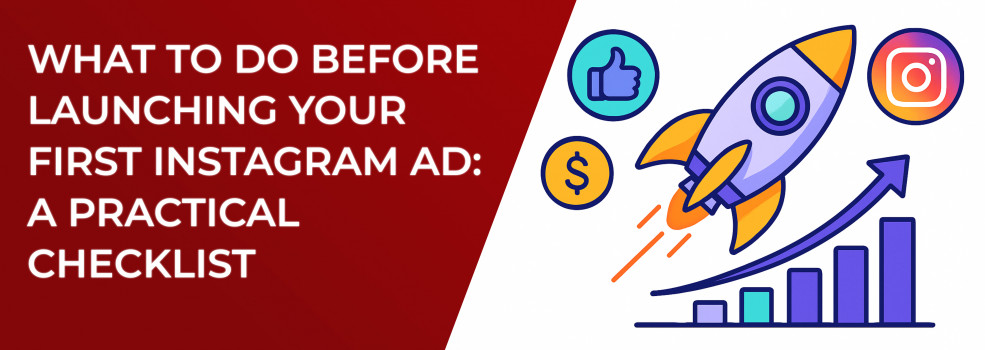Running Instagram ads can feel like skydiving — thrilling, a bit intimidating, and expensive if you pull the wrong cord. A clear pre-launch sequence protects your budget and lifts the results that matter: conversions. The roadmap below covers strategy, creative, targeting, and measurement so you can rise above the average conversion rate and reach profitable growth.
1 Define the one conversion that matters
Instagram lets you optimise for purchases, email sign-ups, add-to-carts, or video views. Pick a single action, write it down, and be sure every stakeholder agrees.
Important: Most studies put the average conversion rate for Instagram ads between 0.8% and 1.3%. Keep that baseline in mind when setting expectations.
For a deeper dive into choosing the right optimisation event, check out our guide Meta Ad Campaign Objectives Explained — it walks through every option and when to use each.
2 Reverse-engineer your funnel math
Before designing a graphic, map the journey from impression to revenue. This quick exercise shows how many sales are needed for a break-even campaign and keeps ad spend disciplined.
If projections veer wildly from these guidelines, find the bottleneck. A strong click-through rate with a weak landing-page conversion means the page needs work.
Key takeaway: Good math prevents panic-driven bid hikes.
3 Install and verify your tracking pixel
Accurate data underpins every high-performing campaign. Make sure the Meta Pixel or Conversions API fires on the exact event you chose. Trigger a test action and confirm it shows up in Events Manager before spending a cent.
4 Build a laser-focused audience
Starting broad drags down business conversion rates. Use warm data first (recent visitors or subscribers), create a 1% lookalike, then add interests only if the pool is still huge. This order keeps cost per acquisition predictable and helps beat typical benchmarks.
Start with warm audiences and expand using lookalikes for better conversion efficiency.
If cold-interest segments still feel overwhelming, Facebook Ad Targeting 101: How to Reach the Right Audience breaks the process down step by step.
5 Craft creatives that persuade, not just entertain
Great visuals grab attention; clear offers close deals.
-
Static images spotlight a single benefit or limited-time discount.
-
Short-form video relies on captions and brisk edits to deliver value inside 15 s.
-
Copy opens with empathy, backs up claims with proof, and ends with urgency.
Need inspiration for vertical video? See how Reels can drive engagement in How to Use Instagram Reels in Your Marketing Strategy.
6 Tune your landing page for speed and continuity
A brilliant ad fails if its destination page is sluggish or confusing. Aim for sub-two-second load times on 4G, mirror the ad’s headline for message match, and present a single call to action.
7 Budget and bid with intent
Meta’s algorithm stabilises after roughly 50 conversion events per week. If volume is too low for purchases, optimise for add-to-cart first, then switch once the account matures.
For a detailed budgeting framework, the post Budgeting for Success: How to Allocate Your Instagram Ad Spend Efficiently provides practical formulas you can apply today.
8 Schedule around user intent
Ads can run 24/7, but conversions aren’t evenly distributed. Platform data shows Tuesday mornings and Thursday evenings often deliver the highest intent for e-commerce. Review hourly reports after a week, then bid more aggressively in your own hot spots.
9 Test systematically and scale winners
1 Run two creatives against one audience until one outperforms by 20% or more.
2 Hold the winner, then split audiences into cold interest, lookalike, and retargeting.
3 Move the top combination to Campaign Budget Optimisation for painless scaling.
Structured testing beats guesswork, scale only what’s proven.
When it’s time to pour fuel on your winners, read Scaling Instagram Ads While Maintaining ROI: What You Need to Know for advanced tactics that keep costs in check.
10 Review, report, refine
Seven days in, compare your numbers to the earlier benchmarks. If you’re ahead, raise budget or expand lookalikes; if you’re behind, revisit creative relevance and landing-page experience before tweaking bids.
To turn raw metrics into next-step actions, bookmark How to Analyze Instagram Ads Performance and Turn Insights into Action.
Quick FAQ
What is an average conversion rate for an Instagram ad?
Around one percent overall, though top performers hit two to three percent.
Are three-percent conversion rates realistic?
Yes—brands with high-intent audiences and tight funnels achieve them regularly.
Does ad fatigue hurt performance?
Absolutely. Rotate visuals or copy every 1,000 impressions per user to stay efficient.
Wrapping up
Launching an Instagram ad is easy; launching one that converts profitably is a disciplined process. Define a clear goal, map your funnel, install reliable tracking, target precisely, craft persuasive creative, optimise your landing page, budget wisely, schedule smartly, test rigorously, and refine with data. Follow these steps and you’ll give your ads the best chance to outpace the average and turn impressions into revenue.

